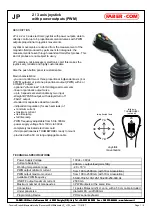
18 ACU-270
SATEL
The mode of operation of wireless detectors depends on the status of partition to which the
zone with wireless detector belongs:
partition disarmed
– the detector operates in
passive mode
. It is a battery saving mode, in
which communication with the controller takes place mainly during time intervals
determined by the R
ESPONSE PERIOD
parameter. At that time, information on violations and
battery status is sent. Only detector tampers are sent immediately.
partition armed
– the detector operates in
active mode
. The detector sends immediately all
information to the controller.
Because switching the detectors over from the passive into active mode and conversely
takes place during the response time, it is performed with some delay in relation to
arming/disarming. The maximum delay – depending on the selected response frequency –
can be 12, 24 or 36 seconds.
The AMD-103 detector and wireless detectors assigned to the 24-hour zones, which are
permanently armed, are in the active mode at all times. Also other wireless detectors can
always work in the active mode, if the A
LWAYS ACTIVE
option is enabled for them (see
p. 13).
According to the EN50131-3 standard all ABAX system Hold-Up devices must be
always in active mode.
Batteries ensure approx. 3 years operation of the detectors, assuming that the
detectors are in passive state for part of that period and the R
ESPONSE PERIOD
is 12
seconds. A longer response period (24 or 36 seconds) means extension of the battery
life time. The battery life time in the detectors switched permanently into the active
mode is shorter than in those which are periodically switched to the passive mode.
However, if the specific character of a detector or its installation place is such that the
number of violations is low, switching the detector permanently into the active mode
will not adversely affect the battery life time.
6.4.2 Wireless sirens
The wireless sirens take up 2 outputs and 2 zones in the system. How the signaling is
controlled by the outputs depends on the siren:
ASP-100
– the first output controls acoustic signaling, and the other one – optical signaling.
The command to start or stop the signaling is sent to the siren immediately. The signaling
stops after the maximum duration of signaling elapses, even if the control output is still
active.
ASP-105
– the first output controls acoustic signaling, and the other one – optical signaling.
The command to start or stop the signaling is sent to the siren immediately. The acoustic
signaling stops after the maximum duration of acoustic signaling elapses, even if the
control output is still active. The optical signaling is active as long as the output is active.
ASP-205
– both outputs control acoustic and optical signaling. Thus two different,
independently triggered ways of signaling can be configured. As a result, the outputs can
separately control the optical and acoustic signaling or signal different alarm types (e.g.
burglary and fire). The command to start the signaling is sent to the siren only during the
response time. Therefore, the cut-off time for the control panel outputs which control the
siren must be longer than the response period. It is recommended that cut-off time
correspond to maximum duration of signaling programmed for the siren. The signaling
stops after the maximum duration of signaling elapses, even if the control output is still
active.








































